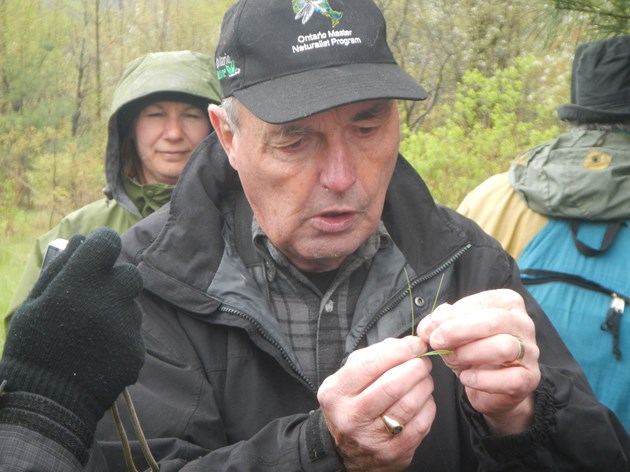‘Nature Talks’ podcast to shine spotlight on Carden Alvar

Orillia naturalist Bob Bowles examines a pine needle as he leads a class as part of the Ontario Master Naturalist Program, which he pioneered. Bowles is featured in a Nature Talks podcast.
News release from Nature Conservancy of Canada
The Nature Conservancy of Canada is bringing Canadians closer to nature through something new – a podcast series dedicated to the subject.
NCC has produced the Nature Talks Podcast, beginning with seven episodes from locations across the country. These highlight special areas and people with the vision of conserving nature, and explores why we need nature in our lives.
Each episode offers an in-depth look at the challenges facing some our most fragile areas and the reasons why conservation action and partnership is needed.
One of the episodes will focus on a unique area east of Orillia that is getting national and international attention. It is where a globally rare alvar is being protected. This habitat is also home to the “butcher bird,” the endangered eastern loggerhead shrike. This songbird is facing real threats, including competition from an invasive species called the dog-strangling vine.
The Nature Talks Podcast features Bob Bowles, an avid naturalist, who uncovered this unique area in 1975 and wanted to see it protected. He noticed the plants and trees were different than he had ever seen before. Bowles has spent years learning and sharing the secrets of this unusual landscape.
Back then he didn’t even have a name for it. Today we know it as the Carden Alvar. Alvars are exceedingly rare ecosystems. They are sometimes called limestone barrens. They’re bare rock, sometimes covered with just a thin layer of soil – wide open expanses of grasses and wildflowers. You’ll only find them in a handful of places around the planet. But, most of the world’s alvars are in Ontario, south of the Canadian Shield.
The 400 different plants found in Carden Alvar go through very harsh environments. It gets completely baked dry in the summer but in the spring it floods when the snow melts. The meltwaters have no place to go so it floods. Plants have to be hardy, enduring spring floods and summer droughts.
Since 1998, the Nature Conservancy of Canada has helped to protect more than nine thousand acres at Carden Alvar. NCC’s Ontario Conservation Director Kristyn Ferguson is leading restoration efforts that include removing the invasive plants that can outcompete native alvar plants. These invasive plants can grow over the open spaces in the alvar, and the unique birds here need that open space to hunt.
“Dog-strangling vine is one of the biggest threats. The rest of the world knows it as pale swallowwort,” said Ferguson. “It’s this soft-stemmed green vine that grows with these little maroon flowers, and it likes just too many habitats. It likes forests, it likes ravines, open places and it loves alvars, which is really unfortunate because it’s so incredibly aggressive. No native predators and nobody really likes to eat it, even our deer or cattle, so off it goes and it can really take over these habitats in no time.
“After a long day of controlling dog-strangling vine all I want to do is forget about it and sometimes you close your eyes at night and you can just see the seed pods, see the leaves on the screens of your eyelids, and you’re like “Get out of my nightmares!” But it keeps me on my toes. I think my active hatred for it really propels the invasive species program forward,” adds Ferguson.
The Carden Alvar is also home to the endangered eastern loggerhead shrike. It’s a songbird, about the size of a robin. It’s a predatory songbird that attacks insects, frogs, mice and even other birds. Shrikes fly close to prey, driving it into something pointy, like thorns, sharp twigs, or barbed wire. And the shrike impales its meal. Hanging its meal the way a butcher hangs its meat. Hence the name…The butcher bird. Wide open alvars are great habitat for this endangered bird. And the Carden Alvar is perfect for a shrike recovery program.
Hazel Wheeler of Wildlife Preservation Canada is the lead biologist with the shrike recovery program. Since 2005, shrikes have been released at the Carden Alvar in efforts to help the population recover. The eastern population of loggerhead shrikes is down to fewer than 100 mature birds. Wheeler explains why this is a crucial area for this endangered bird and how the recovery program is making an impact.
People can subscribe to the NatureTalks Podcast by visiting the Nature Conservancy of Canada’s website: www.natureconservancy.ca/podcast. They can also download and subscribe on iTunes, find it on Stitcher or their favourite podcast app.
People can also support the podcast and our conservation work by visiting www.natureconservancy.ca/podcast and donate on that page. They can also contribute to the discussion on Twitter by using the hashtag #NatureTalksPodcast.









Leave a Reply